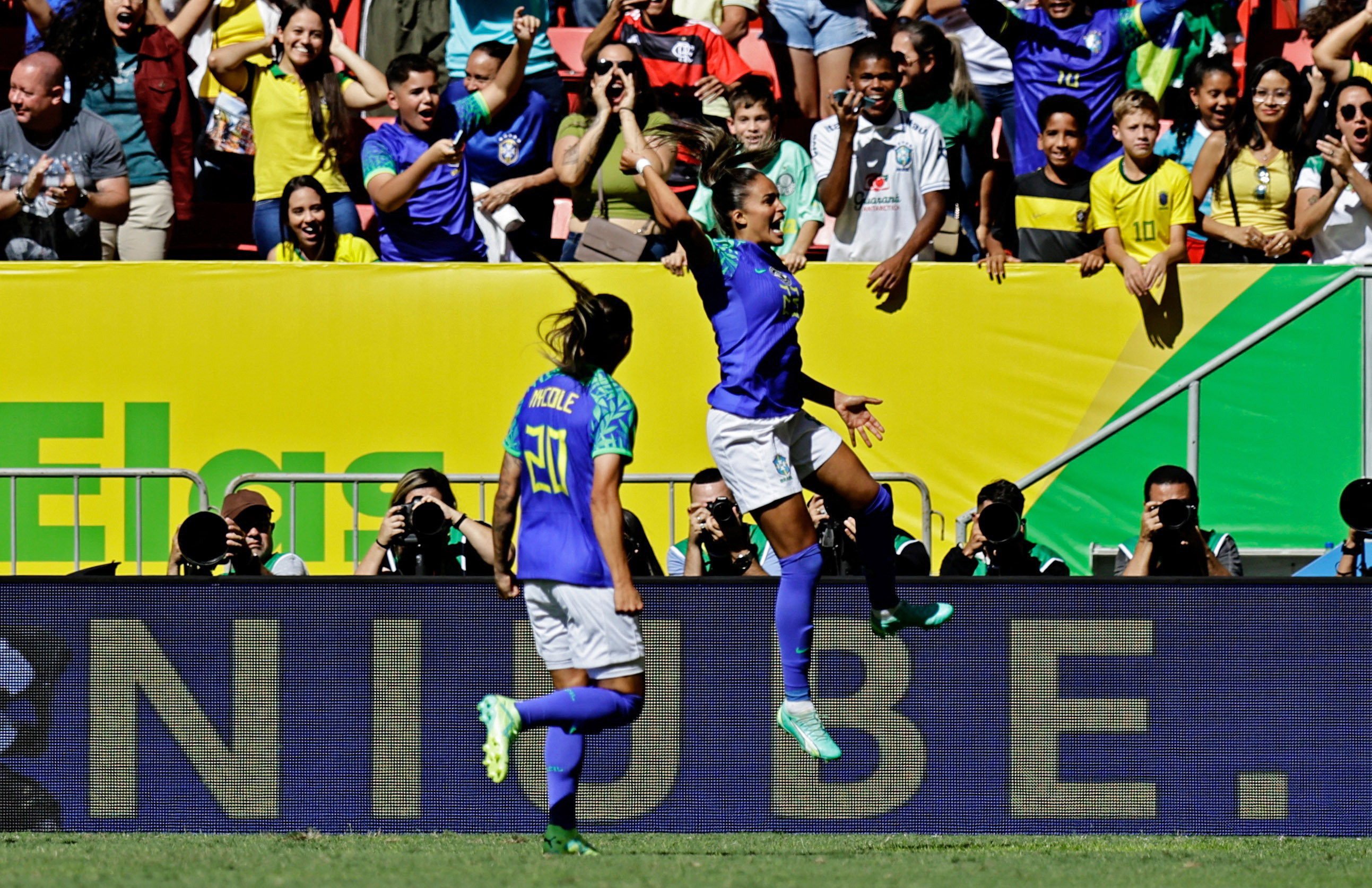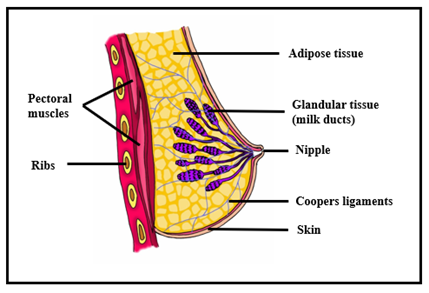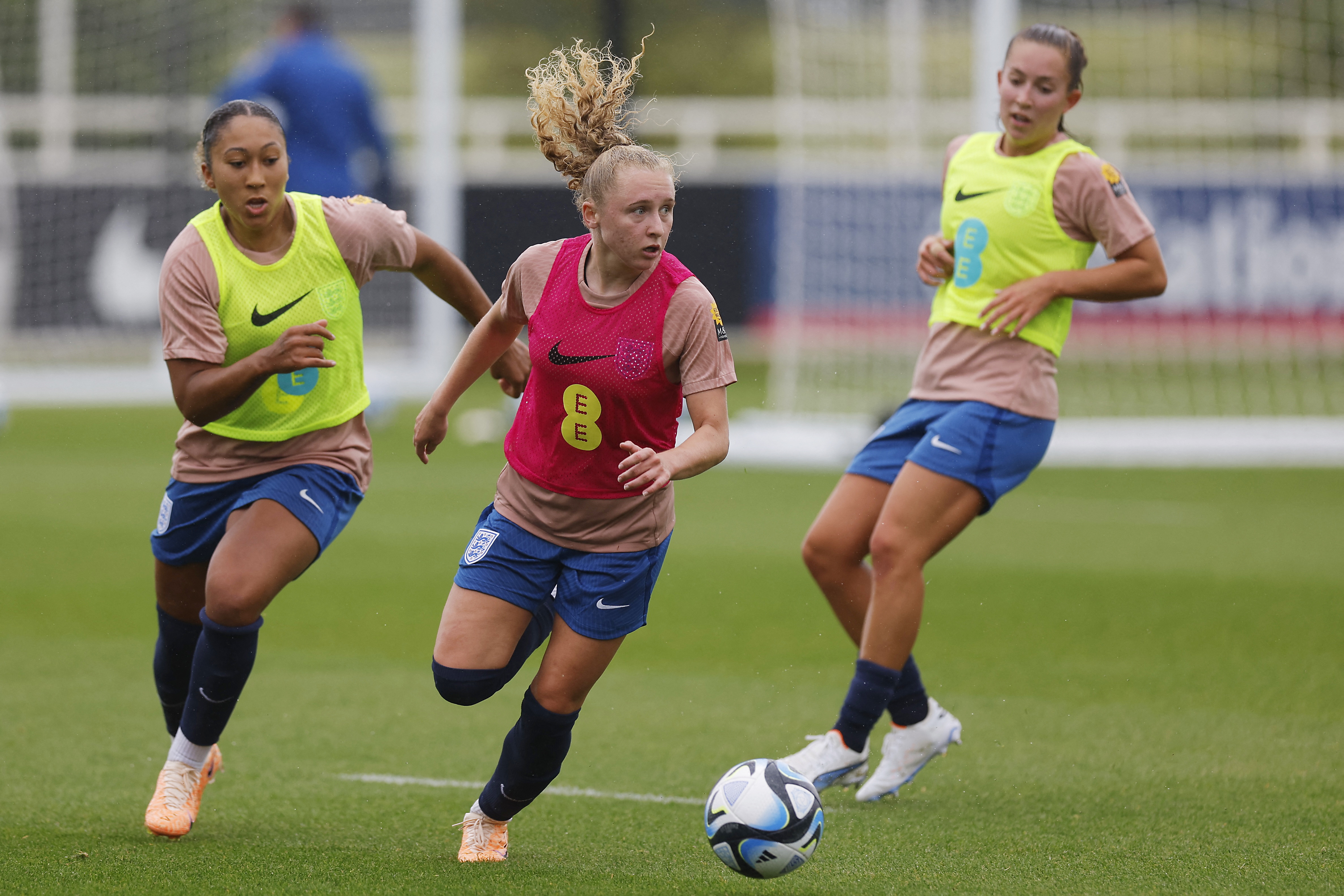You are viewing 1 of your 1 free articles
Breast support - only the balls should bounce!
The breast has limited anatomical support and can move 15cm during running. Nicola Brown discusses the consequences of breast movement and provides guidance on obtaining the correct sports bra fit to help women exercise in greater comfort.
Brazil’s Gabi Nunes celebrates scoring their first goal with Nycole Raysla REUTERS/Ueslei Marcelino
The evolution of technology and sportswear aims to improve performance and prevent injuries. However, the sports industry regularly overlooks sports bras. The first sports bra was developed in 1977 and has undergone many advancements. However, currently, the use of a sports bra in physical activity remains relatively low despite women experiencing breast pain and bra fit issues(1). Additionally, while athletes may feel comfortable discussing their injuries, they may be hesitant about breast-related issues.
Researchers at the University of Wollongong in Australia found that although 58% of athletes reported suffering a contact breast injury during the season, with nearly half reporting an effect on their performance, the coaches and medical staff estimated fewer than 5% of players had sustained a breast injury(2). Furthermore, at the 2020 Tokyo Olympic Games, it was the first time Team GB female athletes received bespoke breast support using innovative technology(3). Therefore, a greater understanding of breast movement during exercise must inform sports bra design and fit to allow women to perform optimally and comfortably.
Breast Anatomy and Movement
The breasts sit on top of the chest wall, with each weighing approximately 200g (A and B cups) to 1000g (≥ D cup)(4,5). The breast does not contain any muscle tissue and comprises adipose and specialized (glandular) tissue that produces milk (see figure 1). The only anatomical support is provided by the skin and fibrous tissue, referred to as Cooper’s ligaments. The Cooper’s ligaments are thin, paper-like tissues that weave throughout the breast and attach to the chest wall. As a result of the limited anatomical support, the breasts may move excessively over the chest wall during physical activity. The movement occurs in three dimensions, with breasts reported to move, on average, 4.2-9.9 cm in the vertical direction, 1.8-6.2 cm in the medial-lateral direction, and 3.0–5.9 cm in the anterior-posterior direction(6,7,8). Thus, breast movement during physical activity may lead to several negative consequences.
Negative consequences of breast movement
Up to 72% of general exercising females and 44% of athletes report pain during exercise(9,10). The incidence of breast pain is relative to size but is not exclusive to women with larger breasts(11). The etiology of breast pain is unknown but may be due to tension on the supporting structures during movement(12). Furthermore, repeated loading may lead to irreparable damage, resulting in accelerated breast ptosis (sag), whereby the nipple migrates downwards below the inframammary fold(13).
Changes in the level of breast support impact performance and result in biomechanical and physiological changes. For example, lower levels of support lead to increased ground reaction forces, which may have injury risk implications(14,15). In addition, running economy is a crucial factor when assessing performance, and less economical upper body patterns are evident when participants run in low-level breast support(16). This is an essential consideration for distance runners since breasts are estimated to bounce ~10,000 times during one hour of slow running(17). Additionally, athletes may reduce their stride length to reduce breast movement, possibly adding an extra mile over a marathon(18). Finally, the independent movement of the breast during activity can be embarrassing and reduce confidence levels, particularly in larger-breasted women(19). These breast-related issues can create a barrier to physical activity participation, with 17% of adult females and 46% of schoolgirls avoiding physical activity because of their breasts(20,21).
Sports bras
Wearing a well-fitted sports bra instead of an everyday bra can limit breast motion during exercise, reduce pain, and improve performance. There are currently three distinct sports bra designs on the market: compression, encapsulation, and combination (see figure 2). Compression bras are typically constructed from one piece of strong elastic material designed to flatten the breasts against the chest wall. Typically, they pull over the head and do not have cups. Encapsulation bras incorporate individual cups to surround and support each breast separately. Finally, combination sports bras encapsulate and compress the breasts to varying degrees, depending on specific design features. There is no consensus on whether one sports bra type is superior. However, compression bras may be more suitable for smaller-breasted women (< D cup), and encapsulation bras for larger-breasted women (≥ D cup)(5). It is common to see sports bras advertised as low, medium, or high-impact, referring to the level of support the bra provides during activities. However, evidence-based standards for these categories have not been established(24). In addition, there are specific design features that may influence the levels of support and comfort:
- Sports bras with higher necklines, i.e., reach the upper boundary of the breast tissue, are considered more supportive(22).
- Vertical, wide (4.5cm), and padded straps improve comfort(23). In addition, various shoulder strap configurations are available, e.g., vertical, cross-over, and racerback, but appear to have little impact on support levels, with the adjustability of straps considered more critical to accommodate varying torso lengths(22,23).
- To help maintain a comfortable breast temperature and avoid skin irritation, material that can wick sweat away from the body may be advantageous.
Getting the best fit
Selecting a well-fitting sports bra can be challenging. There is a wide choice of brands, styles, and sizes on the market and a lack of standardization of sizing(25,26). Additionally, breasts can change size, shape, and position throughout the menstrual cycle and at different life stages(27). Therefore, it is unsurprising that approximately 85% of women wear ill-fitting bras(8). Researchers at the University of Portsmouth found that the traditional tape measurement method is unreliable as it overestimates the underband size and underestimates the cup size(26). Instead, education on professional bra fitting criteria improves the ability to choose a well-fitted bra (see figure 3)(25,26,28).
Conclusion
The negative consequences of an ill-fitting bra impact physical activity participation and performance. The appropriate sports bra fit is essential to reduce breast pain, injury, and embarrassment. Unfortunately, many women wear inappropriate and ill-fitting breast support garments during exercise. Thus, breast support and bra selection education are essential to reduce long-term health issues and performance impairments.
References
- Phys Sportsmed. 1979;7(4):125–8.
- Sci Med Footb. 2020; 4(2): 148-155.
- The Guardian. 2021; 18 Jun.
- Technol Health Care. 2007;15(4):259-71.
- Sports Med. 1999;27(4):205–11.
- Br J Sports Med. 2008;42(8):670–3.
- J Sports Sci. 2011;29(1):55-61.
- Exerc Sport Sci Rev. 2020;48(3):99-109.
- Phys Sportsmed. 1980;8(10):88–97.
- J Sports Sci. 2020;38(5):528-533.
- Br J Sports Med. 2014;48(4):320–325.
- J Sci Med Sport. 1999;2(2):134–144.
- Clin Plast Surg. 1976;3(2):193-203.
- Thesis. 2001:Eugene Oregon;Microform Publication
- Ergonomics.2009;52(4):492–498.
- Hum Mov Sci. 2015;42:246-60.
- Appl Ergon. 2013;44:112–118.
- 31st International Conference on Biomechanics in Sport. 2013.
- Med Sci Sports Exerc. 2010;42(7):1333–8.
- J Phys Act Health. 2015;12(4):588-594.
- J Adolesc Health. 2016;58(2):167-173.
- Text Res J. 2012;83(14):1500–13.
- Sports Med Open. 2015;1(1):21.
- The Exercising Female: Science and Its Application. 2018. Routledge.
- J Sci Med Sport. 2010;13(6):568–72.
- Ergonomics. 2012;55(6):704–11.
- Chiropr Osteopat. 2008;13;16:1.
- Fibres Text East Eur. 2019;27(4):17–22.
Newsletter Sign Up
Subscriber Testimonials
Dr. Alexandra Fandetti-Robin, Back & Body Chiropractic
Elspeth Cowell MSCh DpodM SRCh HCPC reg
William Hunter, Nuffield Health
Newsletter Sign Up
Coaches Testimonials
Dr. Alexandra Fandetti-Robin, Back & Body Chiropractic
Elspeth Cowell MSCh DpodM SRCh HCPC reg
William Hunter, Nuffield Health
Be at the leading edge of sports injury management
Our international team of qualified experts (see above) spend hours poring over scores of technical journals and medical papers that even the most interested professionals don't have time to read.
For 17 years, we've helped hard-working physiotherapists and sports professionals like you, overwhelmed by the vast amount of new research, bring science to their treatment. Sports Injury Bulletin is the ideal resource for practitioners too busy to cull through all the monthly journals to find meaningful and applicable studies.
*includes 3 coaching manuals
Get Inspired
All the latest techniques and approaches
Sports Injury Bulletin brings together a worldwide panel of experts – including physiotherapists, doctors, researchers and sports scientists. Together we deliver everything you need to help your clients avoid – or recover as quickly as possible from – injuries.
We strip away the scientific jargon and deliver you easy-to-follow training exercises, nutrition tips, psychological strategies and recovery programmes and exercises in plain English.













